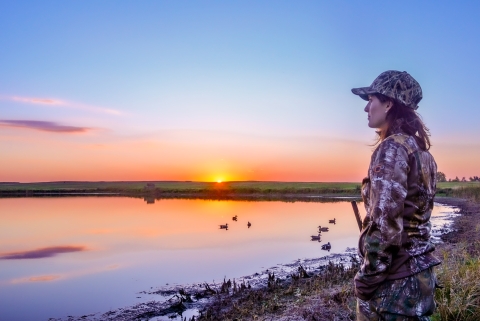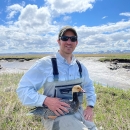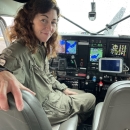States
Alaska, Oregon, WashingtonEcosystem
CoastalOverview
Dusky Canada Geese (Branta canadensis occidentalis) comprise one of the smallest populations of geese in North America. The primary nesting area for dusky Canada Geese is the Cooper River Delta, near Cordova, Alaska, and a smaller population on Middleton Island in the Gulf of Alaska. The famous Great Alaskan Earthquake (or Good Friday Earthquake) of 1964 altered the Copper River Delta significantly, uplifting it, changing its tidal inundation, and drying slough banks and meadows. This resulted in direct alterations of the nesting grounds, which became drier shrubbier, and indirectly increased predation on the nesting geese. The first aerial surveys of the Copper River Delta were done in the 1970s by the Alaska Department of Fish & Game, after declines in dusky Canada Geese were noticed on their breeding and wintering grounds. The U.S. Fish and Wildlife Service took over the surveys in 1983 and continues the survey today.
The results of this aerial count are used in combination with ground counts on Middleton Island to determine hunting regulations for the subspecies. Specific objectives of the project are to 1) determine a population index to guide harvest strategies, 2) document changes in distribution of nesting geese, and 3) count Trumpeter Swans in addition to geese.
Dusky Canada Geese are managed cooperatively under state and federal waterfowl regulations according to the Ducky Canada Goose Management Plan by the Pacific Flyway Council. Unlike other states, hunting is allowed in Alaska in spring and summer in certain rural areas for subsistence needs. The council works with the Alaska Migratory Bird Co-management Council to develop regulations and coordinate management of this species (and other migratory birds).
Importance of this Work
Collaboration and cooperation with other state governments, agencies, and tribes is essential to the conservation of the dusky Canada Goose. The USFWS Alaska Migratory Bird Program works directly with state and tribal partners to protect this Alaska-breeding species. The work we do ensures sustainable harvest for subsistence and sport hunters alike.
Actions We All Can Take
Giving them space: disturbance. Waterfowl like many birds, rely on a variety of habitats throughout the year to rest, feed, and raise young. It is important to avoid disturbing birds by keeping your dog on leash, watching birds from a distance, and limiting interactions that may flush birds needlessly.
Leave the Lead. Smart hunting practices help conserve birds for future generations. Remember to use steel shot for hunting (lead shot is illegal). If you enjoy fishing, remember to properly dispose of monofilament line, lead weights, and hooks. If left in the water, these items often cause injury or death to birds, fish, and other wildlife. Lead poisoning is a serious hazard for birds. Most tackle, especially weights and jigs, are made of lead, which is a toxic metal that can be fatal when ingested by birds and other wildlife. Tragically, many of these poisoned birds are not rescued until it is too late.
Smart Hunting Practices. Stewardship of our harvested species takes all of us. Follow all hunting regulations for the area and for species you are hunting. Only shoot birds you can reliably identify, and most importantly, practice safe hunting practices Remember, some waterfowl, like Emperor Geese, are slower to reproduce, so it is best to take juveniles or opt for other species if possible. Following the annual harvest limits set by biologists is critical to make sure hunting isn’t negatively impacting a species’ population. By setting and following sustainable harvest, we can ensure that hunting is not an additional stressor to the Dusky Canada Goose population. Harvest limits are a controlled way to prevent overexploitation of a species and ensure hunting remains a balanced activity alongside other efforts addressing threats Dusky Canada Geese face.





